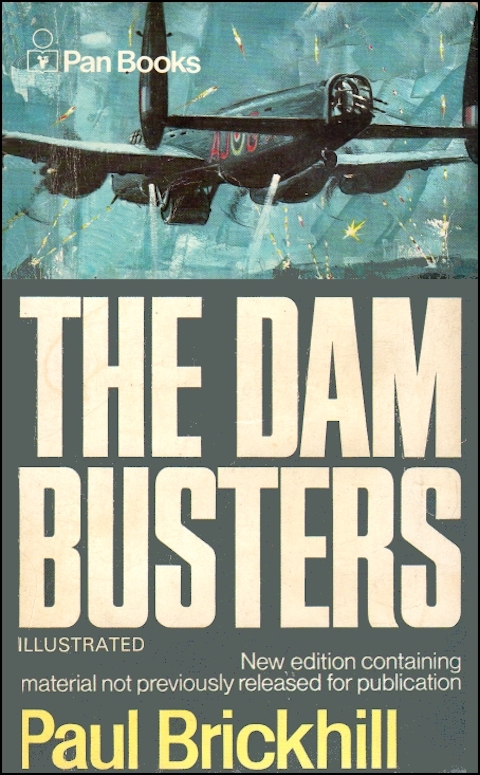
Pic: http://www.tikit.net
In the mid 1950s, Paul Brickhill was one of the best-known authors in the world. He was also one of the most successful, with three huge bestsellers to his name: The Great Escape, The Dam Busters and Reach for the Sky. All three had also been made into films, which had netted him even more money.
By the end of the next decade, however, his personal circumstances had changed. He had been hit by large tax demands and had ended up leaving his native Australia for years at a time. His marriage had broken up, with his wife citing physical assault during the divorce proceedings. He had also suffered several periods of mental ill-health, not helped by periods of heavy drinking.
He eventually returned to Australia in December 1969, where he told a journalist from The Australian newspaper that he was ‘heading for a little pad in Sydney’ where he would ‘settle down to write three books’. Two would have a war theme, he said, and the third would be non-fiction. [Stephen Dando-Collins, The Hero Maker, Vintage Books Australia, 2016, pp.356-7.]
The non-fiction book he mentioned was in fact a revised edition of the Pan Books paperback of The Dam Busters. During his travels, he had spent some time in London going through some of the official records about the raid which had been declassified. The information he gleaned from this principally referred to the fact that the Barnes Wallis-designed weapon used to attack the dams ‘bounced’ and then skipped when it hit the surface of the lake. This was hardly a secret anymore, since it had played a central role in the 1955 film, but until Brickhill sat down to write a revised edition, anyone reading the account in his book would have found vague references to the bomb ‘working’, without any clarification of exactly what this meant.
Brickhill’s biographer, Stephen Dando-Collins describes the painful way in which the work proceeded:
No longer could he dash off a manuscript in a few months. For a year and a half following his 1969 return to Sydney, Brickhill laboured over his rewrite of The Dam Busters. Still hooked on booze and sleeping draughts, he found it a monumental struggle, but he rated himself the kind of person who never gave up. By the time he completed the task, he’d deftly inserted another 12,000 words into The Dam Busters. In early 1971, he completed correcting proofs of the new edition.
[The Hero Maker, p.360.]
Unfortunately, the Pan Book archives don’t have either a list of changes or a copy of the revised manuscript, so the only way of working out what revisions were made is by comparing the two published editions.
Here is Brickhill’s account of one of the earliest test drops of the weapon, on 12 December 1942.

Left, 1954 edition, p.35. Right, 1972 edition, p.42
The revised paragraph is a good reminder of what a fine descriptive writer Brickhill could be:
‘… then, oh the thrill, out of the spray the black barrel came soaring a hundred yards across the water, hit with another flashing feather of spray and soared out again, hit again, and again, the distances shortening every time until at last, after nearly half-a-mile, it slithered to a foaming stop and sank.’
Here is a later section, where the newly formed squadron is undertaking test drops of the weapon at Reculver.

Left, 1954 edition, p.63. Right, 1972 edition, p.78
Although Dando-Collins refers to Brickhill importing the new material from the declassified files, it is likely that a lot of the additions were in fact from Brickhill’s own notes compiled for the original edition. He would have been given a lot of information for this off the record, particularly by Barnes Wallis. His re-creation of the scene in the Wellington cockpit in the first example above, for instance, reads as though it is a story told to him by Wallis – one he would have recorded on disk at the time and then had transcribed. He is likely to have kept all his transcripts from the early 1950s and worked through them at the same time as he was incorporating the classified material.
That there are substantial differences between the two editions of The Dam Busters is not widely appreciated today. Some historians have only looked at the earlier version before using it as a source, and it would be wise to check up on what Brickhill added to the 1972 edition before quoting it.
As for the rest of the projects which Brickhill had said in 1969 were now his priority, none saw the light of day. The nearest to being finished was the biography of an American prisoner of war, Major Johnny Dodge, who he had met in Stalag Luft 3. He had done eighty per cent of the work on this, he told the Sydney Sunday Telegraph in 1981. It was however still incomplete at the time of his death ten years later, on 23 April 1991.
If there is a criticism to be made of Brickhill’s work is that it never shows any of the flaws which his principal characters displayed. Roger Bushell (the mastermind behind the Great Escape), Guy Gibson and Douglas Bader were only human; each of them could be said to be single-minded and not to suffer fools gladly. By being uncritical of their flaws, Brickhill made them heroes. The truth is a little more complicated than that, and it has been the work of later scholars to reveal this. Brickhill was, however, a writer of gripping narrative history and it is this which is still remembered today.
Source: Stephen Dando-Collins, The Hero Maker, Vintage Books Australia, 2016.
Thanks to Tim at tikit.net for the use of his cover picture of the 1972 edition. There is a selection of different covers on this page.

